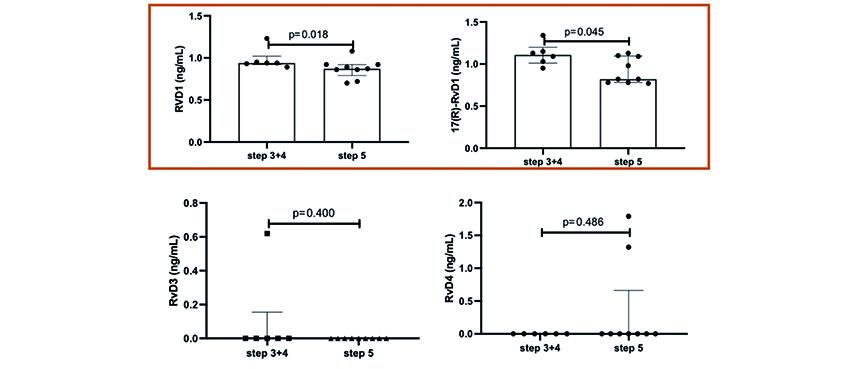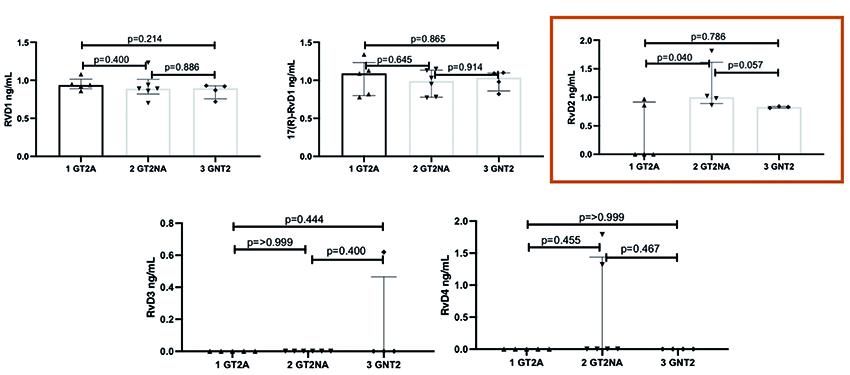29th National Conference of the Italian Society for the Study of Hemostasis and Thrombosis, 2025
Vol. 4 No. s1 (2025)
PO54 | Resolvin response in bronchial asthma patients: endotype and clinical severity
R. Liani1, I. Altomare2, P.G.M. Simeone1, M. Alfonsetti1, M. Mucci3, D. Madonna1, S. Lattanzio1, A. Ricci4, A.M. Draicchio2, A. De Sanctis2, P. Di Mattia2, F. Papa2, E. Cavallucci2, F. Cipollone1, A. Recchiuti3, F. Santilli1 | 1Department of Medicine and Aging, and Center for Advanced Studies and Technology “CAST”, G. d’Annunzio University of Chieti-Pescara, Chieti; 2Allergy and Immunology Section, Department Internal Medicine, G. d’Annunzio University, School of Medicine, Chieti; 3Department of Medical, Oral and Biotechnological Sciences, and Center for Advanced Studies and Technology “CAST”, G. d’Annunzio University, Chieti-Pescara; 4Department of Pharmacy, University G. d’Annunzio of Chieti Pescara, Chieti, Italy
Publisher's note
All claims expressed in this article are solely those of the authors and do not necessarily represent those of their affiliated organizations, or those of the publisher, the editors and the reviewers. Any product that may be evaluated in this article or claim that may be made by its manufacturer is not guaranteed or endorsed by the publisher.
All claims expressed in this article are solely those of the authors and do not necessarily represent those of their affiliated organizations, or those of the publisher, the editors and the reviewers. Any product that may be evaluated in this article or claim that may be made by its manufacturer is not guaranteed or endorsed by the publisher.
Published: 22 October 2025
38
Views
0
Downloads
Similar Articles
- PO26 | Non-canonical coagulation platelets function: monocyte-platelet interaction a bridge between inflammation and coagulation , Bleeding, Thrombosis and Vascular Biology: Vol. 4 No. s1 (2025)
- PO55 | Evaluation of safety and efficacy of emicizumab prophylaxis in pediatric patients with hemophilia A – a single centre experience , Bleeding, Thrombosis and Vascular Biology: Vol. 4 No. s1 (2025)
- PO87 | Intravascular leiomyomatosis extending to the right atrium: a case report with a multidisciplinary management , Bleeding, Thrombosis and Vascular Biology: Vol. 4 No. s1 (2025)
- PO27 | B-cell lymphoproliferative disorder and acquired coagulopathy: an insidious link , Bleeding, Thrombosis and Vascular Biology: Vol. 4 No. s1 (2025)
- PO56 | Safety of anticoagulant treatment in patients with splanchnic vein thrombosis and history of portal hypertension-related bleeding , Bleeding, Thrombosis and Vascular Biology: Vol. 4 No. s1 (2025)
- PO88 | Bacterial lysate “lantigen B” induces proliferation of B and NK cells and the release of related cytokines , Bleeding, Thrombosis and Vascular Biology: Vol. 4 No. s1 (2025)
- PO28 | Long term effectiveness and safety of venous thromboembolism with fondaparinux: data from the start registry , Bleeding, Thrombosis and Vascular Biology: Vol. 4 No. s1 (2025)
- PO57 | Direct oral anticoagulant determination in urine samples compared to plasma concentrations in outpatients with atrial fibrillation and obesity , Bleeding, Thrombosis and Vascular Biology: Vol. 4 No. s1 (2025)
- PO89 | Apixaban for secondary prevention of venous thromboembolism in hemodialysis patients: pharmacokinetic profile and safety outcomes , Bleeding, Thrombosis and Vascular Biology: Vol. 4 No. s1 (2025)
- PO29 | Quality of anticoagulation as a predictor of early left ventricular thrombosis resolution: a retrospective cohort study , Bleeding, Thrombosis and Vascular Biology: Vol. 4 No. s1 (2025)
1-10 of 95
Next
You may also start an advanced similarity search for this article.










